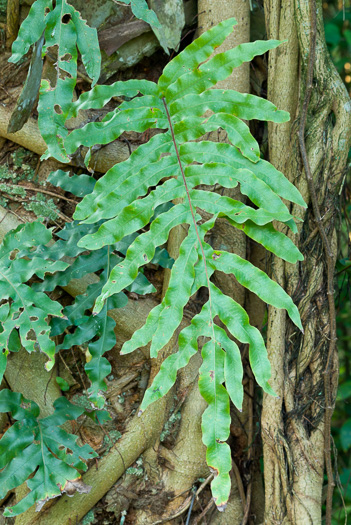Monilophytes (ferns): Leptosporangiate Ferns (true ferns): Polypodiales
WEAKLEY'S FLORA OF THE SOUTHEASTERN US (4/24/22):
Phlebodium aureum
FAMILY
Polypodiaceae
Go to FSUS key
Dig deeper at SERNEC, a consortium of southeastern herbaria.
SYNONYMOUS WITH
PLANTS NATIONAL DATABASE:
Phlebodium aureum
FAMILY
Polypodiaceae
SYNONYMOUS WITH Flora of North America
Phlebodium aureum
SYNONYMOUS WITH Flora of the Bahama Archipelago (Correll & Correll, 1982)
Polypodium aureum
SYNONYMOUS WITH Ferns of the Southeastern States (Small, 1938)
Phlebodium aureum
COMMON NAME:
Goldfoot Fern, Golden Polypody
To see larger pictures, click or hover over the thumbnails.
Keith Bradley kab_p_aureum_05916
February Miami-Dade County FL
Krome Bird Refuge
Frond 40-90cm long; blade w 4-9 pr of pinnae, the terminal one to 30cm long, per Field Guide to the Ferns and Other Pteridophytes of Georgia (Snyder & Bruce, 1986).
WEAKLEY'S FLORA OF THE SOUTHEASTERN US (4/24/22):
Phlebodium aureum
FAMILY
Polypodiaceae
SYNONYMOUS WITH
PLANTS NATIONAL DATABASE:
Phlebodium aureum
FAMILY
Polypodiaceae
SYNONYMOUS WITH
Flora of North America
Phlebodium aureum
SYNONYMOUS WITH
Flora of the Bahama Archipelago (Correll & Correll, 1982)
Polypodium aureum
SYNONYMOUS WITH
Ferns of the Southeastern States (Small, 1938)
Phlebodium aureum
If a search such as "Carex leptalea var. leptalea" doesn't deliver the results you want, try "Carex leptalea".
Or, to minimize chances of a misspelling, try just "Carex le".
Less is more: If "pencil flower" doesn't deliver the results you want, try "pencil".


